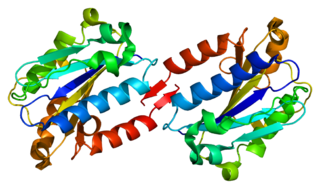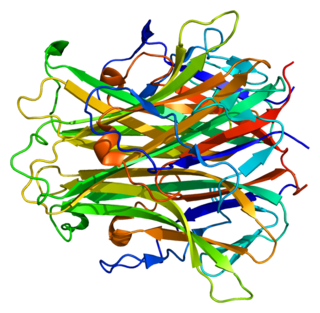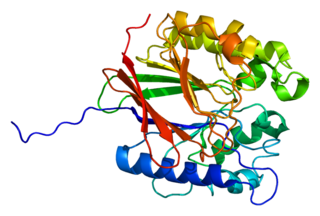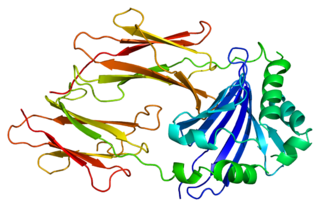Dendrocyte expressed seven transmembrane protein is a protein that in humans is encoded by the DCSTAMP gene. [5]
Dendrocyte expressed seven transmembrane protein is a protein that in humans is encoded by the DCSTAMP gene. [5]
This gene encodes a seven-pass transmembrane protein that is primarily expressed in dendritic cells. The encoded protein is involved in a range of immunological functions carried out by dendritic cells. This protein plays a role in osteoclastogenesis and myeloid differentiation. Alternate splicing results in multiple transcript variants. [provided by RefSeq, Mar 2012].

Complement receptor type 1 (CR1) also known as C3b/C4b receptor or CD35 is a protein that in humans is encoded by the CR1 gene.

Integrin, alpha L , also known as ITGAL, is a protein that in human is encoded by ITGAL gene. CD11a functions in the immune system. It is involved in cellular adhesion and costimulatory signaling. It is the target of the drug efalizumab.

Receptor activator of nuclear factor kappa-Β ligand (RANKL), also known as tumor necrosis factor ligand superfamily member 11 (TNFSF11), TNF-related activation-induced cytokine (TRANCE), osteoprotegerin ligand (OPGL), and osteoclast differentiation factor (ODF), is a protein that in humans is encoded by the TNFSF11 gene.

Chemokine ligand 18 (CCL18) is a small cytokine belonging to the CC chemokine family. The functions of CCL18 have been well studied in laboratory settings, however the physiological effects of the molecule in living organisms have been difficult to characterize because there is no similar protein in rodents that can be studied. The receptor for CCL18 has been identified in humans only recently, which will help scientists understand the molecule's role in the body.

Tartrate-resistant acid phosphatase, also called acid phosphatase 5, tartrate resistant (ACP5), is a glycosylated monomeric metalloprotein enzyme expressed in mammals. It has a molecular weight of approximately 35kDa, a basic isoelectric point (7.6–9.5), and optimal activity in acidic conditions. TRAP is synthesized as latent proenzyme and activated by proteolytic cleavage and reduction. It is differentiated from other mammalian acid phosphatases by its resistance to inhibition by tartrate and by its molecular weight.

Leukocyte antigen CD37 is a protein that in humans is encoded by the CD37 gene.

HLA class II histocompatibility antigen, DRB5 beta chain is a protein that in humans is encoded by the HLA-DRB5 gene.

HLA class II histocompatibility antigen, DM beta chain is a protein that in humans is encoded by the HLA-DMB gene.

HLA class II histocompatibility antigen, DM alpha chain is a protein that in humans is encoded by the HLA-DMA gene.

Decoy receptor 3 (Dcr3), also known as tumor necrosis factor receptor superfamily member 6B (TNFRSF6B), TR6 and M68, is a soluble protein of the tumor necrosis factor receptor superfamily which inhibits Fas ligand-induced apoptosis.

C-type lectin domain family 7 member A or Dectin-1 is a protein that in humans is encoded by the CLEC7A gene. CLEC7A is a member of the C-type lectin/C-type lectin-like domain (CTL/CTLD) superfamily. The encoded glycoprotein is a small type II membrane receptor with an extracellular C-type lectin-like domain fold and a cytoplasmic domain with a partial immunoreceptor tyrosine-based activation motif. It functions as a pattern-recognition receptor for a variety of β-1,3-linked and β-1,6-linked glucans from fungi and plants, and in this way plays a role in innate immune response. Expression is found on myeloid dendritic cells, monocytes, macrophages and B cells. Alternate transcriptional splice variants, encoding different isoforms, have been characterized. This gene is closely linked to other CTL/CTLD superfamily members on chromosome 12p13 in the natural killer gene complex region.

Leukocyte-associated immunoglobulin-like receptor 1 is a protein that in humans is encoded by the LAIR1 gene. LAIR1 has also been designated as CD305.

Chloride channel 7 alpha subunit also known as H+/Cl− exchange transporter 7 is a protein that in humans is encoded by the CLCN7 gene. In melanocytic cells this gene is regulated by the Microphthalmia-associated transcription factor.

Transmembrane glycoprotein NMB is a protein that in humans is encoded by the GPNMB gene. Two transcript variants encoding 560 and 572 amino acid isoforms have been characterized for this gene in humans. The mouse and rat orthologues of GPNMB are known as DC-HIL and Osteoactivin (OA), respectively.

Osteopetrosis-associated transmembrane protein 1 is a protein that in humans is encoded by the OSTM1 gene. It is required for osteoclast and melanocyte maturation and function.

Osteoclast-associated immunoglobulin-like receptor is a protein that in humans is encoded by the OSCAR gene.

CD205 also called Lymphocyte antigen 75 is a protein that in humans is encoded by the LY75 gene.

Zinc finger protein 366, also known as DC-SCRIPT, is a protein that in humans is encoded by the ZNF366 gene. The ZNF366 gene was first identified in a DNA comparison study between 85 kb of Fugu rubripes sequence containing 17 genes with its homologous loci in the human draft genome.

C-type lectin domain family 2 member D is a protein that in humans is encoded by the CLEC2D gene.
This article incorporates text from the United States National Library of Medicine, which is in the public domain.